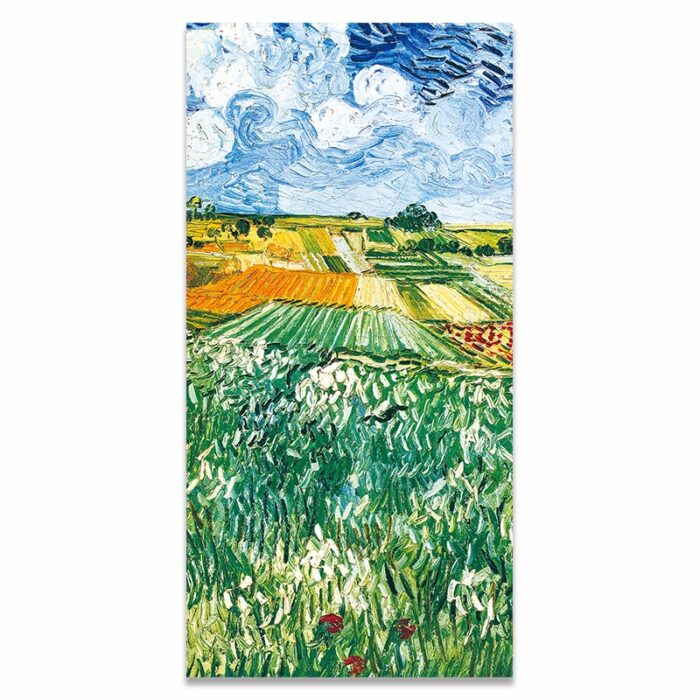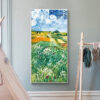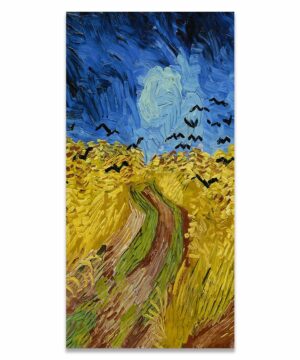Vincent van Gogh’s landscape paintings like “Plain near Auvers” have left us with numberless questions when dying in 1890. He is often referred to as the ‘painter of the sunflowers’ – or otherwise as to the ‘mad artist’. Today van Gogh is regarded as one of the most admired Post-impressionist painters. Although he only sold one of his works during his lifetime, his work has been sold after his death for record numbers. The most expensive of van Gogh’s paintings was the portrait of doctor Paul Gachet, who took care of the artist in the final months of his life in the commune displayed in this picture of “Plain near Auvers”. Van Gogh’s Auvers paintings, his expressive and emotive use of vivid colour, and the brisk application of impastoed paint can give us some insight into the artist’s innermost thoughts.
Where is the picture “Plain near Auvers” today?
Vincent van Gogh’s landscape paintingLandscape painting focuses on the depiction of natural scenery such as mountains, valleys, trees, rivers, and forests. It has been a significant genre in art history, evolving through various styles and periods. Landscape painting captures the beauty of the natural world and often reflects the cultural and philosophical views of the time. JMW Turner, Calais Pier, 1801 Historical Context Landscape More “Plain near Auvers” is on permanent display at the Neue Pinakothek in Munich, Germany.
What’s in it?
The paintingPainting is a fundamental form of visual art that has been practiced for thousands of years. It involves applying pigment to a surface such as canvas, paper, or a wall. Painting can be explored through various styles, techniques, and mediums, each offering unique possibilities for expression and creativity. Historical Background • Ancient Beginnings: The history of painting dates back to More shows an immense plain near Auvers-Sur-Oise, fields with wheat stacks, framed by lush trees, reaching up to a hill, the scenery vibrating under the strong Provençal sunlight in delicate tonesIn color theory, a tone is a version of a color created by adding gray (a mix of black and white) to the original hue. This concept is essential for artists and designers as it allows for a wide range of colors that are neither too dark nor too light, providing versatility in creating depth, mood, and harmony within a More of yellow. Van Gogh emphasizes the high rising blade of grass and little red poppies in the foreground, resonating with the seemingly fast-moving clouds in a sky with different tonesIn color theory, a tone is a version of a color created by adding gray (a mix of black and white) to the original hue. This concept is essential for artists and designers as it allows for a wide range of colors that are neither too dark nor too light, providing versatility in creating depth, mood, and harmony within a More of azure-blue, creamy white, pink, and violet. As typical for his late style, colours are applied in fiery brushstrokes with ridges of thick impasto, making the motives appear almost haptic tangible.
What’s the context?
Van Gogh, Auvers-Sur-Oise, facts:
- Vincent van Gogh’s wheat fields near Auvers is one of more than 30 pictures that the artist frantically created in the months before his death in the Summer of 1890, among them the famous paintingPainting is a fundamental form of visual art that has been practiced for thousands of years. It involves applying pigment to a surface such as canvas, paper, or a wall. Painting can be explored through various styles, techniques, and mediums, each offering unique possibilities for expression and creativity. Historical Background • Ancient Beginnings: The history of painting dates back to More “Maison Auvers-Sur-Oise” (Vincent van Gogh’s “Houses at Auvers”), Van Gogh’s “View of Auvers”, “Doctor Gachet’s Garden in Auvers”, Van Gogh’s “Church at Auvers” (“Eglise Auvers-Sur-Oise”), and “Farms near Auvers” (“Ferme Auvers-Sur-Oise”).
- He had just left an asylum In Saint-Rémy, where he had been treated for mental health problems and had travelled to the commune Auvers-Sur-Oise located northwest of Paris.
- In Auvers, he sought the supervisory care and companionship by physician Paul Gachet, whom he painted a world-renowned portrait of. Another famous paintingPainting is a fundamental form of visual art that has been practiced for thousands of years. It involves applying pigment to a surface such as canvas, paper, or a wall. Painting can be explored through various styles, techniques, and mediums, each offering unique possibilities for expression and creativity. Historical Background • Ancient Beginnings: The history of painting dates back to More created shortly before his death is Vincent van Gogh’s “Doctor Gachet’s Garden in Auvers”.
- Many artists before van Gogh had worked in Auvers for inspiration by the scenery for their plein air paintingPainting is a fundamental form of visual art that has been practiced for thousands of years. It involves applying pigment to a surface such as canvas, paper, or a wall. Painting can be explored through various styles, techniques, and mediums, each offering unique possibilities for expression and creativity. Historical Background • Ancient Beginnings: The history of painting dates back to More, among them Honoré Daumier, Camille Corot, Paul CézannePaul Cézanne (1839–1906) is often hailed as the "father of modern art." His pioneering approach to painting laid the groundwork for the transition from 19th-century artistic traditions to the radically different styles of the 20th century. Known for his innovative use of color, brushstrokes, and composition, Cézanne's work profoundly influenced future generations of artists, including the Fauves, Cubists, and Abstract More, Camille Pissarro, Jean-Baptiste-Camille Corot, Armand GuillauminArmand Guillaumin, a French painter born in 1841, is renowned for his vivid landscapes and cityscapes. As a prominent figure in the Impressionist movement, his use of bold colors and light has left a lasting impression on the art world. Armand Guillaumin, Self Portrait Early Life and Background • Birth: February 16, 1841, in Paris, France. • Family: Middle-class family More, and Charles-François Daubigny.
- As we know from van Gogh’s letters to his brother Theo, he adored and had been absorbed by the landscape and the town of Auvers. He wrote: Auvers is very pretty…, there is countryside all around, typical and picturesque.” Vincent van Gogh’s “Church at Auvers” (Van Gogh “Église Auvers-Sur-Oise”) is one of his most famous paintings and can be seen at Musée d’Orsay in Paris today.
- However, he also admitted feeling very depressed despite the idyllic surroundings: “There are vast fields of wheat under troubled skies, and I did not need to go out of my way to express sadness and extreme loneliness.”
Chatter and Prattle
- Most art historians agree that as letters from van Gogh indicate, the artist most likely committed suicide in the summer of 1890, just a few days after he painted “Plain near Auvers”. A newer but highly controversial theory puts forth, that he might have been shot by a young boy who liked to pester the artist.
- Despite the support of doctor Gachet, van Gogh purportedly must have shot himself in the chest with a Lefaucheux revolver and died from his injuries two days later.
- The landscapes painted in the weeks preceding his death have been widely interpreted as reflecting van Gogh’s inner emotions and thoughts. Apart from art historians, the pictures in combination with the letters he wrote to his brother, his sister, and his mother have further served psychologists as materials for studying mental health issues.
- At the Musée Van Gogh Auvers-Sur-Oise, also known as “Maison de van Gogh” or “Maison Van Gogh Auvers-Sur-Oise”, visitors to Auvers-Sur-Oise can still look at the room where the artist lived and died.
Recommended Readings:
This article may contain compensated links. Please read Disclaimer for more info. As an Amazon Associate, I earn from qualifying purchases.
Ingo F. Walther et al. (2020): Van Gogh. The Complete Paintings
Vincent Van GoghVincent van Gogh (1853 – 1890) is one of the renowned Post-Impressionist artists, best known for his striking use of colour, emphatic brushwork, and contoured forms. As a son of a pastor, the Dutch artist war brought up in a religious and cultured atmosphere. After working unsuccessfully as a clerk at a bookstore, as a salesman, and as a preacher More (2020): The Letters of Vincent Van Gogh
Martin Gayford (2008): The Yellow House: Van Gogh, Gauguin, and Nine Turbulent Weeks in Provence
Steven Naifeh et al. (2012): Van Gogh: The Life (RANDOM HOUSE)
Steven Naifeh (2021): Van Gogh and the Artists He Loved













1 review for Plain near Auvers by Van Gogh – Canvas Giclée Print
There are no reviews yet.